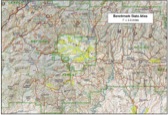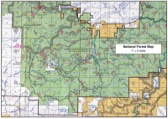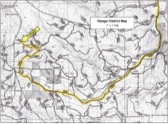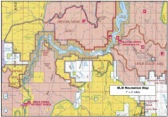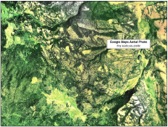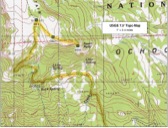Less Traveled Northwest
Day Hikes for the Adventurous
Map Resources for Backcountry Travel
Trip Planning Maps
When planning a trip into unfamiliar territory, a State Travel Atlas is a helpful tool. The best ones we’ve found are by Benchmark Maps, at a scale of about 1” = 4 miles. These give a good overview of travel distances, road types, and land ownership. For the specific areas in which we’re interested, we make 11”x17” color copies of the relevant State Atlas pages, tape them together into a composite, then highlight the paved roads, the primary gravel roads, the developed campgrounds and drinking water sources. From this a rough travel plan emerges.
Maps of Forest Service Lands
The Forest Service publishes two levels of map detail for each forest: a National Forest Map and several Ranger District Maps. The National Forest Maps (aka Recreation Maps) are large color, 4’x4’ folded maps at a scale of 1” = 2 miles. These give a valuable “second opinion” on the State Atlas information. Often, a National Forest Map is all you’ll need for general travel on forest lands.
The Ranger District Maps (aka Fireman Maps) are also giant folded maps about 4’x4’, but at a scale of 1” = 1 mile. These are black and white, contour base maps over which the Forest Service road network is drawn. Also included are road numbers, gates, closed roads, fence lines, private inholdings. These maps are essential for exploring in especially remote forest areas.
To purchase these maps from the Forest Service, see their website for each individual national forest.
Maps of BLM Lands
The BLM has recently begun publishing a Recreation Map Series, covering each BLM district. These are large color, 4’x4’ folded maps at the scale of 1” = 2 miles. They are comparable in detail to the National Forest Maps above, showing land ownership, road networks and developed recreation sites. These also show areas with motorized travel restrictions where roads are closed or limited in use. These Recreation Series Maps are by far the best available for travel on BLM lands.
Unfortunately, the BLM no longer publishes more detailed maps of the lands they manage. If you need more detail, the best option is USGS topo maps, either the 30x60 minute series (1” = 1.6 miles) or the 7.5 minute series (1” = 0.4 miles).
To purchase maps from BLM, see the website for each individual BLM District.
Aerial Photo Coverage
Since aerial photography is now so freely available online (Google Maps or Bing Maps), it’s easy to print out aerial photos ahead of time for each area you plan to visit. These color aerials provide unique information that just can’t be gleaned from maps alone. For example, we’ve discovered newly constructed roads, areas that have recently burned, and forests recently killed by pine beetles — all in places that we’ve planned to visit. So do take advantage of this free resource, available online to the backcountry trip planner.
Day Hiking Maps
The standard hiking map is still the USGS 7.5 minute topographic series (1” = 0.4 miles). These are now widely available in digital form, so you can purchase topo maps for an entire state on just a few discs. However, before leaving home, you’ll need to print out all the topo maps for the areas you plan to visit — or else pack your laptop in the car, along with a portable printer.
For each hike on this website, we provide a USGS topo map, as well as a detailed road map to each trailhead, both as PDF downloads.
Map Summary
In sum, the map gathering process for backcountry travel is:
1. Order a State Atlas from Benchmark Maps for your area of interest.
2. Order either a National Forest Map or a BLM Recreation Map for your area.
3. If you need more detailed road maps, order either Ranger District Maps
(for USFS lands) or USGS topographic maps (for BLM lands).
4. Print out aerial photos from Google Maps or Bing Maps (optional).
5. Print out USGS 7.5 minute topo maps — or just download the ones we've provided.
Page last updated: 12/17/11

